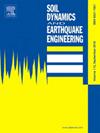Optimal device strength distribution rule for pin-supported wall frame structures
IF 4.2
2区 工程技术
Q1 ENGINEERING, GEOLOGICAL
引用次数: 0
Abstract
Pin-supported wall frame structure is a typical type of rocking structure that limits structural damage under earthquakes. Previous studies arrange uniform-strength devices along the wall height or use concentrated devices at the wall hinge, which overlooks the impact of different device strength height-wise distributions on the bending moments of pin-supported walls. This paper proposes an Optimal Device Strength Distribution Rule (ODSDR) for pin-supported walls with the objective to minimize the absolute wall bending moment and the construction cost. The proposed ODSDR is based on an analytic model and comprises three major steps: (1) formulation of demand equations for seismic actions and floor bending moments; (2) development of capacity equations induced by dampers and pin-supported wall; and (3) establishment of a damper design equation focused on minimizing the absolute bending moments of pin-supported walls. Then, a six-story pin-supported wall frame structures model was created in OpenSees to validate the proposed method. Devices were designed according to the ODSDR and distributed along the building height, as well as for comparison with uniform devices distributed along the building height and devices concentrated at the pin-supported wall hinge. The results from the analysis model were compared with those obtained from the OpenSees model, and the seismic performance of three device allocation methods was evaluated. The results demonstrate that the ODSDR can effectively reduce the bending moments in the walls without compromising seismic performance.
求助全文
约1分钟内获得全文
求助全文
来源期刊

Soil Dynamics and Earthquake Engineering
工程技术-地球科学综合
CiteScore
7.50
自引率
15.00%
发文量
446
审稿时长
8 months
期刊介绍:
The journal aims to encourage and enhance the role of mechanics and other disciplines as they relate to earthquake engineering by providing opportunities for the publication of the work of applied mathematicians, engineers and other applied scientists involved in solving problems closely related to the field of earthquake engineering and geotechnical earthquake engineering.
Emphasis is placed on new concepts and techniques, but case histories will also be published if they enhance the presentation and understanding of new technical concepts.
 求助内容:
求助内容: 应助结果提醒方式:
应助结果提醒方式:


